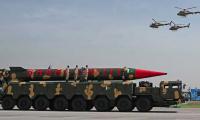Calls for war crimes probe against Israel
Ag Agencies
GAZA CITY: More than 58,000 Palestinians have been displaced by Israel’s bloody air strikes that have destroyed or badly damaged nearly 450 mainly civilian buildings in Gaza, the UN aid agency said on Tuesday.
In a separate statement on the conflict, rights group Amnesty International said Israel air strikes on residential buildings might amount to war crimes. Israel denies it.About 47,000 of the displaced civilians have sought shelter in 58 UN-run schools in Gaza, Jens Laerke, a spokesman for the United Nations Office for the Coordination of Humanitarian Affairs (OCHA) in Geneva, told reporters.
Laerke said 132 buildings had been destroyed and 316 had been severely damaged, including six hospitals and nine primary healthcare centres as well a desalination plant, affecting access to drinking water for about 250,000 people.
The UN agency welcomed the fact that Israel had opened a border crossing for humanitarian supplies but called for another crossing to also be opened.The UN and its humanitarian partners are providing food and other assistance to displaced families when the security situation allows, Laerke said. There is a severe shortage of medical supplies, a risk of water-borne diseases and the spread of Covid-19 because of displaced people crowding into schools, said Margaret Harris, a spokeswoman for the World Health Organisation.
London-based Amnesty International called for an investigation into Israeli air strikes on residential buildings in Gaza on Tuesday.“Israeli forces have displayed a shocking disregard for the lives of Palestinian civilians by carrying out a number of airstrikes targeting residential buildings in some cases killing entire families - including children - and causing wanton destruction to civilian property, in attacks that may amount to war crimes or crimes against humanity,” Amnesty said.
Israel says it strikes only sites it deems military targets. It says that it regularly issues prior warnings to evacuate buildings it sees as legitimate targets. At least 225 Palestinians, including 61 children and 35 women, have been killed and 1,305 others injured in Israeli airstrikes, according to the latest figures.
Amnesty, which urged both sides last week not to violate humanitarian law, said it had documented four deadly attacks by Israel launched on residential homes without prior warning and called on the International Criminal Court to investigate the brutal killings.
It said Israeli strikes on May 11 destroyed two residential buildings belonging to the Abu al-Ouf and al-Kolaq families, killing 30 people, 11 of them children. A mother and three children were killed on May 14 when the al-Atar family’s three-storey building was hit, it said.
It said the home of Nader Mahmoud Mohammed Al-Thom, where he lives with eight others, was attacked without warning on May 15.Meanwhile, Egyptian President Abdel Fattah al-Sisi pledged on Tuesday $500 million to help reconstruction efforts in Gaza, his office said, after a week of brutal Israeli air strikes on the Palestinian enclave.
"Egypt will provide $500 million... for the reconstruction process in the Gaza Strip as a result of recent events, with expert Egyptian construction companies implementing the rebuilding," the presidency said in a statement.
Hamas can count on abundant stocks of rockets and other weaponry in its ongoing conflict with Israel, with the Palestinian militant group boasting an even deeper and more effective arsenal than in previous standoffs, according to analysts.
Reports say, Hamas is able to fire more frequently and further into Israel compared with past conflicts over Gaza. Here is a look at Hamas’ arsenal, how it has evolved in recent years and what effect it has on the current conflict.
The Islamist movement, in power in Gaza despite an Israeli blockade for nearly 15 years, has surprised Tel Aviv and other Israeli cities with its response and frequency of its strikes. More than 3,000 rockets have fallen on Israel in the past week, a pace aimed at overwhelming Israel’s Iron Dome missile defence system.
For the first time, Hamas used the Ayyash 250 missile, which has a range of 250 kilometres (155 miles). "The most impressive fact of this war is just how many rockets they managed to fire in a short period of time and simultaneously," said Fabian Hinz, an independent analyst who focuses on missiles in the Middle East.
"Hamas’s firepower, both in terms of number of rockets and their reach, far surpasses earlier escalations, and Israeli retaliation has been swift and devastating," said the International Crisis Group (ICG).
"Militarily, Israel was caught off guard by Hamas’ expanded operational capacity to fire so many rockets at once and at such distant targets," it added.
Lieutenant General Igor Kirillov, who was chief of Russia’s Nuclear, Biological and Chemical Protection Troops. —...
US President-elect Donald Trump speaks at an event in West Palm Beach, Florida. — AFP/File WASHINGTON: Donald Trump...
Refugees sleep outside the entrance of the Swedish Migration Agency's arrival centre for asylum seekers at Jagersro in...
UN Special Envoy for Syria Geir Pedersen attends a news conference ahead of the meeting of the Syrian Constitutional...
India's Prime Minister Narendra Modi shows his ink-marked finger after casting his vote during the third phase of the...
Moscow has courted relations with Taliban since they seized power in Afghanistan in 2021







